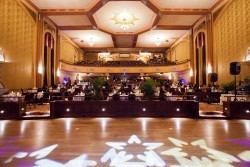
The Suffolk Theater in historic downtown Riverhead, New York opened its doors for the first time in 1933, thriving for decades before closing in 1987. Under new ownership, the venue has been renovated and recently reopened, and beneath its carefully-restored Depression-era art-deco façade is a modern audio/video/lighting system that includes a 36-input/20-output Symetrix SymNet Radius 12×8 Dante networked DSP system.
Theatre and A/V designer Stuart Allyn of A.D.R. Studios (Irvington, New York) designed and commissioned the new theatrical/audio/video systems at The Suffolk Theater, and Theatrical Services and Supplies (Hauppauge, New York) installed it.
“Of course, a lot of thought goes into every aspect of a system like this,” says Allyn. “I went with the SymNet Radius 12×8 because it’s a cost-effective processor that is totally flexible, both in terms of its processing power and its input/output count.”
The Suffolk Theater needed a large number of inputs and outputs because the entire system throughout the building is fed from the central FOH position. A wide number of areas (bars, offices, restrooms, backstage, etc.) are all capable of receiving the main show audio (and video in some cases) plus each area, at the touch of a button, can optionally receive a local source such as cable TV or a Blu-ray player.
Each area when viewing the stage feed must be time aligned to the stage, and when viewing local sources that timing needs to be synced to the video. Each “zone” required speaker processing for each mode of operation. By having all the system processing centralized and separate, sound mixers using the digital mixing system are free to use whatever systems, EQs etc. they desire to use in the console, while the main speaker and system processing remains in place.
The Symetrix system helps facilitate all of it very easily. To the 12 inputs and 8 outputs of the system’s single Radius 12×8, Allyn added two Symetrix SymNet xIn 12 expansion boxes and one Symetrix SymNet xOut 12. Like all products in the Symetrix SymNet Radius and Edge family, the expansion boxes connect to the processor via the robust, low-latency Dante network protocol.
“We’ve used a lot of Symetrix products in the past, and we’ve never had issues,” Allyn states. “Symetrix equipment sounds good and works well at commissioning and over the long haul. In addition, I like using SymNet Composer to build customized processing. I can see the entire system on one screen, and that overview is important to me. Then I can drill down as needed.”
The system includes comprehensive Crestron control, but that didn’t stop Allyn from making cost-effective use of Symetrix’ inexpensive ARC-2e wall panel remotes. Eight ARC-2e’s placed at strategic locations in ancillary rooms and spaces allow users to select from presets and to change input sources and volumes. Indeed, several of the Symetrix ARC-2e’s send command strings to the SymNet Radius 12×8 system and to the system’s Crestron video switcher.
Although the super low latency Dante network plays no larger role in the system, the scalability of the Symetrix SymNet system via Dante was a critical factor in its selection. “We designed the system with foresight of possible future expansion in mind,” Allyn concludes. “There’s a lot of extra wiring in place that will allow them to expand the stage and the dressing room areas. If needed, we can simply add another Symetrix SymNet Radius 12×8 to the system via Dante to accommodate even more inputs, outputs, and processing. It is a beautiful venue that should provide great entertainment to Long Island for many years to come.”
